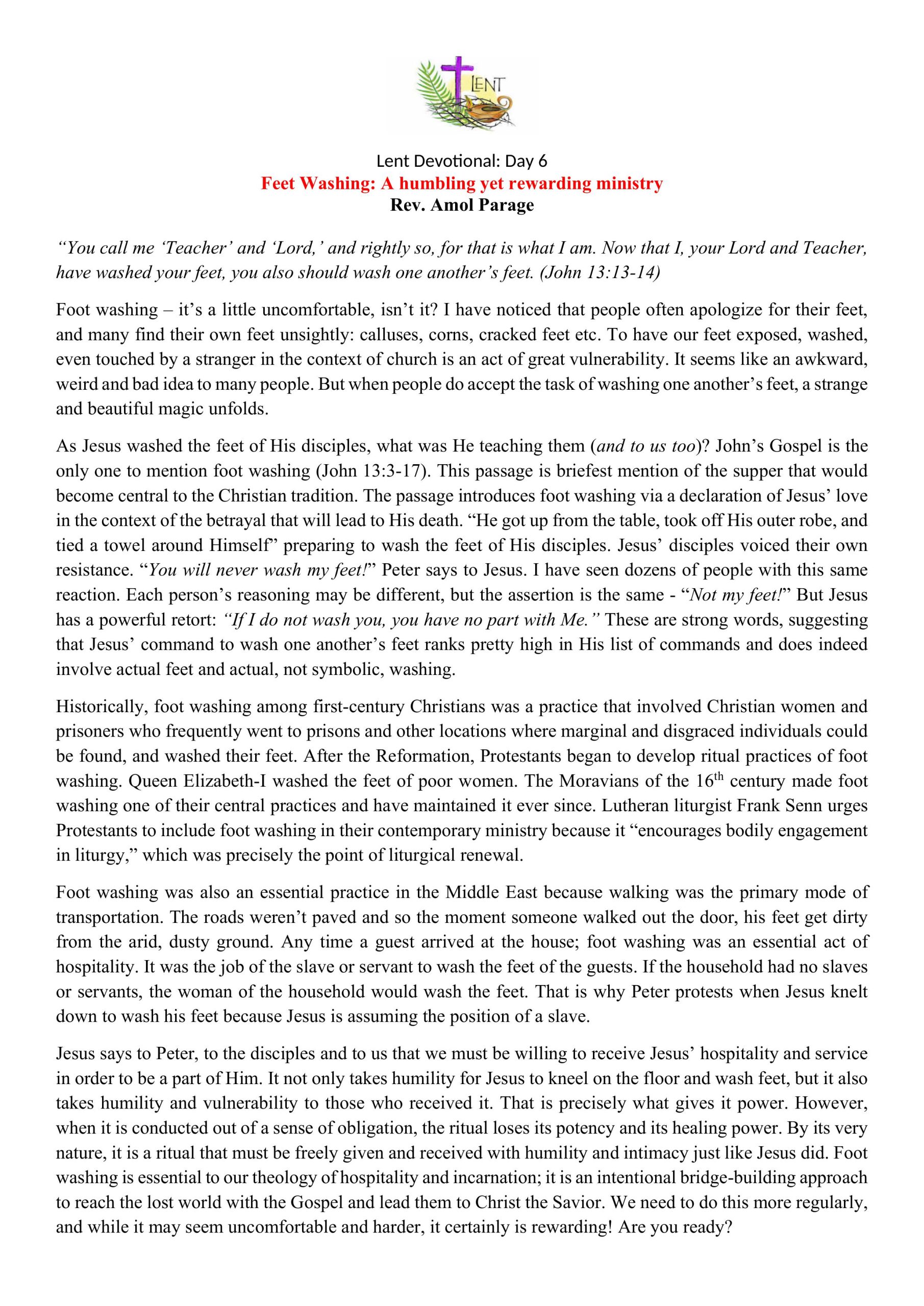2025 Lent Devotional – Day 6

2025 lent devotional, lent, Lent 2025
Lent Devotional: Day 6
Feet Washing: A humbling yet rewarding ministry
Rev. Amol Parage
“You call me ‘Teacher’ and ‘Lord,’ and rightly so, for that is what I am. Now that I, your Lord and Teacher, have washed your feet, you also should wash one another’s feet. (John 13:13-14)
Foot washing – it’s a little uncomfortable, isn’t it? I have noticed that people often apologize for their feet, and many find their own feet unsightly: calluses, corns, cracked feet etc. To have our feet exposed, washed, even touched by a stranger in the context of church is an act of great vulnerability. It seems like an awkward, weird and bad idea to many people. But when people do accept the task of washing one another’s feet, a strange and beautiful magic unfolds.
As Jesus washed the feet of His disciples, what was He teaching them (and to us too)? John’s Gospel is the only one to mention foot washing (John 13:3-17). This passage is briefest mention of the supper that would become central to the Christian tradition. The passage introduces foot washing via a declaration of Jesus’ love in the context of the betrayal that will lead to His death. “He got up from the table, took off His outer robe, and tied a towel around Himself” preparing to wash the feet of His disciples. Jesus’ disciples voiced their own resistance. “You will never wash my feet!” Peter says to Jesus. I have seen dozens of people with this same reaction. Each person’s reasoning may be different, but the assertion is the same – “Not my feet!” But Jesus has a powerful retort: “If I do not wash you, you have no part with Me.” These are strong words, suggesting that Jesus’ command to wash one another’s feet ranks pretty high in His list of commands and does indeed involve actual feet and actual, not symbolic, washing.
Historically, foot washing among first-century Christians was a practice that involved Christian women and prisoners who frequently went to prisons and other locations where marginal and disgraced individuals could be found, and washed their feet. After the Reformation, Protestants began to develop ritual practices of foot washing. Queen Elizabeth-I washed the feet of poor women. The Moravians of the 16th century made foot washing one of their central practices and have maintained it ever since. Lutheran liturgist Frank Senn urges Protestants to include foot washing in their contemporary ministry because it “encourages bodily engagement in liturgy,” which was precisely the point of liturgical renewal.
Foot washing was also an essential practice in the Middle East because walking was the primary mode of transportation. The roads weren’t paved and so the moment someone walked out the door, his feet get dirty from the arid, dusty ground. Any time a guest arrived at the house; foot washing was an essential act of hospitality. It was the job of the slave or servant to wash the feet of the guests. If the household had no slaves or servants, the woman of the household would wash the feet. That is why Peter protests when Jesus knelt down to wash his feet because Jesus is assuming the position of a slave.
Jesus says to Peter, to the disciples and to us that we must be willing to receive Jesus’ hospitality and service in order to be a part of Him. It not only takes humility for Jesus to kneel on the floor and wash feet, but it also takes humility and vulnerability to those who received it. That is precisely what gives it power. However, when it is conducted out of a sense of obligation, the ritual loses its potency and its healing power. By its very nature, it is a ritual that must be freely given and received with humility and intimacy just like Jesus did. Foot washing is essential to our theology of hospitality and incarnation; it is an intentional bridge-building approach to reach the lost world with the Gospel and lead them to Christ the Savior. We need to do this more regularly, and while it may seem uncomfortable and harder, it certainly is rewarding! Are you ready?